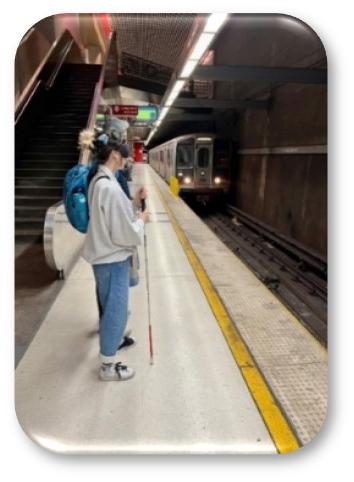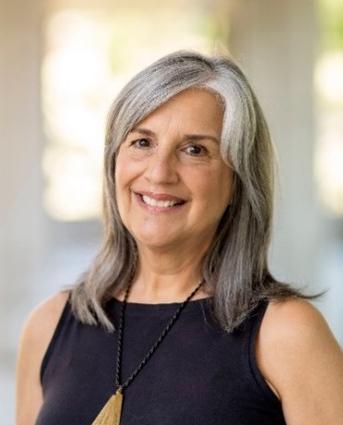


The Orientation & Mobility (O&M) program prepares specialists to teach independent travel skills and concepts to infants, children, and adults who are blind or visually impaired. This program provides extensive hands-on training and fieldwork experiences with coursework in visual impairment, theory and effective teaching practices. Candidates in this program are dually enrolled in the M.A. degree in Special Education, Option in Orientation and Mobility and the Clinical or Rehabilitative Services Credential in Orientation and Mobility
program highlights

O&M Program highlights include:
- Federal grant funding (for eligible candidates) to pay for tuition and most textbooks.
- Completion of an M.A. degree and Credential in one (intensive) year.
- Eligibility to take the exam for national certification offered by the Academy on Certification of Vision Rehabilitation and Education Professionals (ACVREP).
- Extensive simulation experiences in a variety of environments (e.g., on campus, residential neighborhoods, business environments, and using public transit) to learn the foundation skills and concepts of orientation and mobility. Link to video with Sleepshade Highlights from 2023.
- Participation in practicum teaching experiences in O&M with both school-aged students and adults with visual impairments.
- Hands-on experiences learning to teach use of the long white cane, low vision devices and other assistive technology to aid orientation and mobility.
Application to the O&M Program
Orientation and mobility for visually impaired persons is a dynamic discipline. Our goal is to meet the needs of the culturally diverse population that we serve. Successful prior employment, volunteer service or personal experience with individuals who are visually impaired is preferred, but not essential. Due to the highly specialized nature of the program and intensive training resources required, there are a limited number of program openings each year.
The Cal State LA Orientation and Mobility (O&M) Specialist Training Program seeks instructor candidates possessing:
- Strong interpersonal communication skills (both verbal and written)
- Common sense and situational awareness
- Intelligence, strong academic ability
- Sensitivity and insight to individual needs
- Creativity
- Dedication to teaching a wide range of students with visual impairments.
University admission requirements for application to the M.A. degree program include a minimum GPA of 2.75 (in some cases, candidates with strong qualifications may be conditionally admitted with a GPA that is lower). Admission requirements for the Credential program require that candidates receive a Certificate of Clearance from the California Commission on Teacher Credentialing (CTC). Upon acceptance to the credential program, candidates must pass the CTC’s Basic Skills Requirements (recommended, but not required to apply).
Application for the O&M program begins with applying for the M.A. degree option through Cal State Apply. Applicants for the O&M program are typically considered for admission in the Summer session and Fall semester. Application deadlines for Summer are typically late February and Fall terms are typically in late May.
All applicants to the Orientation and Mobility Specialist Training Program must complete:
- An application to the university through Cal State Apply for the M.A. Degree in Special Education, option in O&M
- An in-person interview
- A minimum of one field observation of a practicing O&M Specialist prior to the interview.
Federal grant support (when available) for this program requires that trainee recipients maintain a 3.0 GPA each semester and overall, carry a minimum courseload of 12-16 units each semester, and plan a course of study resulting in completion of the MA program in four consecutive academic terms (e.g., Fall semester, Winter Session, Spring Semester, Summer Session). Candidates who accept grant support agree to a service obligation to work with children with visual impairments.
Please contact Anne Jeanette Dwight at [email protected] who will be happy to respond to any questions you have about the application process. If you have any questions relating to the O&M program, please feel free to contact Dr. Nicholas Casias at [email protected] or Brenda Naimy at [email protected]
Is O&M For Me?

- teaching 1:1 with students with visual impairments of all ages, cultures, and abilities,
- seeing students learn skills that lead to greater independence in movement and travel,
- working in a variety of indoor and outdoor community environments, such as schools, home neighborhoods, and business areas, and
- having a wide range of employment options, including public schools, and private, state and federal agencies, and private contracting,
then a career as an Orientation and Mobility (O&M) specialist may be for you. Read more about O&M and watch the videos in the following links to learn more about O&M!
There are a wide variety of career opportunities for O&M specialists. As a graduate of the master's degree program in Special Education, Option in Orientation & Mobility, one may find work as an Orientation & Mobility Specialist with the following employers:
- Public, private, and residential schools serving infants, children and youth who are blind or visually impaired.
- Private agencies serving adults who are blind or visually impaired.
- Veteran’s Administration Hospitals with Blind Rehabilitation Centers or Low Vision Outpatient Centers serving veterans who are blind or visually impaired.
- State rehabilitation agencies, state commissions for the blind, and state rehabilitation agencies and centers providing services for individuals who are blind or visually impaired.
- Regional centers or state departments of developmental services for individuals who have developmental disabilities including blindness.
- Companies that provide short- and long-term professional staffing in the field of visual impairment.
- Self-employment as an independent contractor (e.g., for the California Department of Rehabilitation and other agencies serving individuals with visual impairments)
All videos play in Verbit accessible smart video player
Preschool O&M
- Watch me Go! Blind Preschooler Uses Cane
- Addie – Day 1. Preschool O&M
- Toddler Cane – Confidence to Go
O&M with Elementary School Student
O&M with Secondary School Student
- LAUSD Student Shows off Advanced O&M Skills!
- Older Youth Shows O&M Skills!
- Cane Quest – O&M Competition for School-Aged Kids
O&M with Adults
O&M is a profession specific to the fields of vision education and rehabilitation that teaches skills and concepts needed for safe movement and travel. Visual impairment, including blindness and low vision, brings unique challenges to independent movement and travel. Without O&M training, individuals with visual impairments may experience difficulties with orientation and may face potential safety risks from tripping or falling, bumping into things, or crossing streets.
- Orientation refers to knowing where you are, as well as how to get to where you want to go. Instruction in orientation skills and concepts focuses on increasing the student’s ability to know where they are in relationship to their surroundings and what route they need to take to get to their desired destination. Developing orientation skills typically includes teaching spatial and environmental concepts, skills in cognitive mapping and spatial updating, and use of assistive technology (e.g., monocular telescope, tactile maps and accessible GPS).
- Mobility refers to the physical movement of travel. Instruction in mobility skills may include teaching a student how to walk using a long cane (or other mobility devices) to detect obstacles in their path, or upcoming drop-offs such as curbs or stairs.
Skills and concepts addressed in O&M instruction may include (but are not limited to):
- Concept development relating to the body, positioning, direction, spatial awareness, and the environment,
- Use of remaining vision, hearing and tactile senses to aid orientation and safe movement,
- Cane techniques for detecting drop-offs (e.g., curbs), obstacles, and changes in ground surface (e.g., uneven surfaces, changes from sidewalk to grass, etc.)
- Route planning skills, ability to follow directions, problem-solving, and soliciting/declining assistance,
- Use of assistive technology apps and devices to aid orientation, route planning and safe movement,
- Street crossing skills and techniques (including analysis of intersections, traffic patterns and traffic control devices)
- Techniques for travel in indoor environments, outdoor residential, small and large business districts, mall travel, and rural areas
- The use of public transportation (e.g., buses, trains, paratransit options) and ride-share options
- The Cal State LA O&M program is one of approximately 15 O&M personnel preparation programs in the U.S., and one of only two in California. In existence for over 55 years, this program has prepared hundreds of highly qualified O&M specialists. Program faculty are highly experienced in working with children and adults with visual impairments and are actively involved in statewide and national organizations that impact the field of O&M. In 2017, Cal State LA celebrated its 50th Anniversary and this video shows a few highlights over the years.
- Program Structure: This is a highly intensive, one-year program that incorporates extensive hands-on training and fieldwork experiences with coursework in visual impairment, theory and effective teaching practices. It is considered “hybrid” in terms of instructional delivery, with extensive in-person work as well as online coursework. Students in the program typically live in the Los Angeles area and surrounding counties, however many have successfully commuted from San Diego, Kern and Santa Barbara counties.
- Time and Transportation Requirements: Due to the intensive nature of the program, including fieldwork during daytime hours and coursework in the evenings, students are not typically able to work while in the program. The exceptions to this are candidates who already possess an Education Specialist Credential in Visual Impairments and are employed as a teacher of students with visual impairments. Reliable transportation will be needed to travel to and from classes held in the community as well as to and from student teaching and internship sites.
Program Faculty
As a part of the O&M MA degree and Credential program, students receive individual advisement and instruction from expert faculty members who combine extensive teaching experience, research, and pre-service and in-service teacher development in Orientation & Mobility. For more information regarding the Orientation & Mobility program, contact any of the faculty below:
Professor
